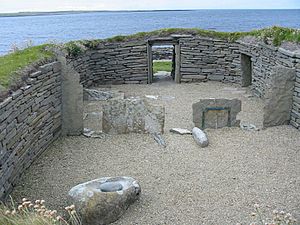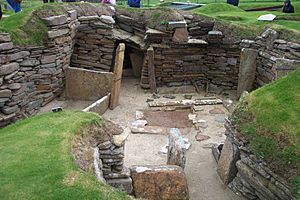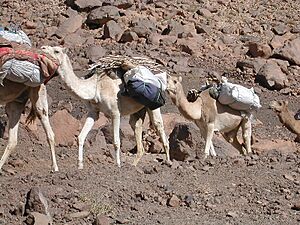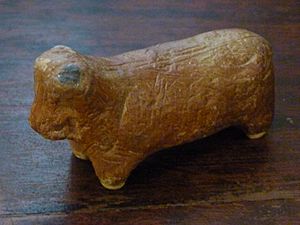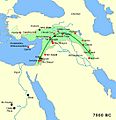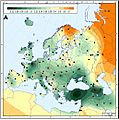Neolithic revolution facts for kids
The Neolithic revolution was the first agricultural revolution. It was a gradual change from nomadic hunting and gathering communities and bands to agriculture and settlement. Vere Gordon Childe coined the term Neolithic Revolution in the 1920s. He thought that it was as important as the Industrial Revolution (which happened in the 18th and 19th century).
The term refers to the general time period over which these developments took place. It also applies to the changes which took place: the adoption of early farming techniques, crop cultivation, and the domestication of animals. Archaeological data indicates that the domestication of various types of plants and animals happened in separate locations worldwide, starting in the geological epoch of the Holocene 11,700 years ago, after the end of the last Ice Age. It was humankind's first historically verifiable transition to agriculture.
The Neolithic Revolution is important for developments in social organization and technology.
The Neolithic revolution led to living in permanent or semi-permanent settlements. Because of this fewer people led a nomadic lifestyle. To be able to know who the crops grown belonged to, the concept of land ownership was developed. The natural environment was changed, population densities grew, and people ate more vegetable and cereal foods in their diet. Hierarchies developed in society. Grain was stored, and could be traded. Surplus production from good crop yields helped societies survive bad years.
Contents
Domestication
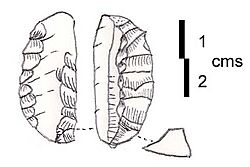
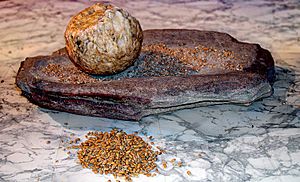
When humans started to selectively breed cereal grasses (beginning with emmer, einkorn and barley) and domesticate certain animals such as dogs, goats, sheep, and cattle, human society changed.
Because people now grew crops and raised livestock they no longer needed to move around. They could build better settlements.
Their diet also changed. It included more oats and vegetables. One of the world's most important crops, barley, was domesticated in the Near East around 11,000 years ago (c. 9,000 BCE). Barley is a highly resilient crop, able to grow in varied and marginal environments, such as in regions of high altitude and latitude. Archaeobotanical evidence shows that barley had spread throughout Eurasia by 2,000 BCE.
Once early farmers perfected their agricultural techniques like irrigation (traced as far back as the 6th millennium BCE in Khuzistan), their crops yielded surpluses that needed storage. Most hunter-gatherers could not easily store food for long due to their migratory lifestyle, whereas those with a sedentary dwelling could store their surplus grain. Eventually granaries were developed that allowed villages to store their seeds longer. So with more food, the population expanded and communities developed specialized workers and more advanced tools.
When hunter-gathering began to be replaced by sedentary food production it became more efficient to keep animals close at hand. Therefore, it became necessary to bring animals permanently to their settlements. The animals' size, temperament, diet, mating patterns, and life span were factors in the desire and success in domesticating animals. Animals that provided milk, such as cows and goats, offered a source of protein that was renewable and therefore quite valuable. The animal's ability as a worker (for example ploughing or towing), as well as a food source, also had to be taken into account. Besides being a direct source of food, certain animals could provide leather, wool, hides, and fertilizer. Some of the earliest domesticated animals included dogs (East Asia, about 15,000 years ago), sheep, goats, cows, and pigs.
West Asia was the source for many animals that could be domesticated, such as sheep, goats and pigs. This area was also the first region to domesticate the dromedary.
These changes happened in several places of the world, independently. They did not happen in the same order though. The earliest farming societies in the Near East did not use pottery. It is still unclear to what extent plants were domesticated in Britain, or if permanently settled communities existed at all. Early Japanese societies used pottery before developing agriculture.
In the Paleolithic there were many different human species. According to current research, only the modern human reached the Neolithic though.
To further elucidate the routes by which barley cultivation was spread through Eurasia, genetic analysis was used to determine genetic diversity and population structure in extant barley taxa. Genetic analysis shows that cultivated barley spread through Eurasia via several different routes, which were most likely separated in both time and space.
Theories about the Neolithic revolution
There are different theories why this transition could have happened:
- Oasis theory: The climate changed, and it got drier. The first humans went to live in or near oases (places where there is more water, in the desert) to be able to survive. Some animals and plants did that too. It was only a small step to domesticate some of the animals that were there. This theory was advocated by Childe himself. Climate data from the period does not support it though.
- The Hilly Flanks theory. It suggests that agriculture began in the hilly flanks of the Taurus and Zagros mountains, and that it developed from intensive focused grain gathering in the region. It was proposed it in 1948.
- The Feasting model suggests that agriculture was driven by displays of power, such as throwing feasts to show dominance. This required assembling large quantities of food which drove agricultural technology.
- The Demographic theories say that the local population grew so much that it was difficult to support it using hunting and gathering alone. More food was needed than could be gathered. Various social and economic factors helped drive the need for food.
- The evolutionary/intentionality theory proposes that agriculture is an evolutionary adaptation of plants and humans. Domestication of wild plants started by protecting them. Later, the location where to grow them was chosen more carefully. Finally they were domesticated.
Reasons why it happened
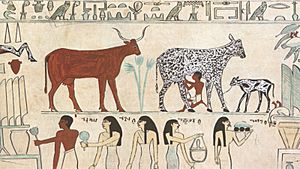
According to Harland, there are three main reasons why the Neolithic revolution happened:
- Domestication for religious reasons. There was a revolution of symbols; religious beliefs changed as well. Venus figurines which have been found could be a hint for this.
- Domestication because of crowding and stress. Many animals died out at the end of the last ice age. The human population had increased to fill all the available land. There was a food crisis. Agriculture was the only way to support the population on the available land.
- Domestication from discovery from the food-gatherers. Food-gatherers where those who cared for the young and who kept the fires alive. With the time, they found out which plants were edible, or would help against certain illnesses. They also helped to domesticate animals (which then travelled with the humans).
Consequences
Social change
Despite the significant technological advance and advancements in knowledge, arts and trade, the Neolithic revolution did not lead immediately to a rapid growth of population. Its benefits appear to have been offset by various adverse effects, mostly diseases and warfare.
The introduction of agriculture has not necessarily led to unequivocal progress. The nutritional standards of the growing Neolithic populations were inferior to that of hunter-gatherers. Several ethnological and archaeological studies conclude that the transition to cereal-based diets caused a reduction in life expectancy and stature, an increase in infant mortality and infectious diseases, the development of chronic, inflammatory or degenerative diseases (such as obesity, type 2 diabetes and cardiovascular diseases) and multiple nutritional deficiencies, including vitamin deficiencies, iron deficiency anemia and mineral disorders affecting bones (such as osteoporosis and rickets) and teeth. Average height for Europeans went down from 178 cm (5'10") for men and 168 cm (5'6") for women to 165 cm (5'5") and 155 cm (5'1") respectively, and it took until the twentieth century for average height for Europeans to return to the pre-Neolithic Revolution levels.
The traditional view is that agricultural food production supported a denser population, which in turn supported larger sedentary communities, the accumulation of goods and tools, and specialization in diverse forms of new labor. Food surpluses made possible the development of a social elite who were not otherwise engaged in agriculture, industry or commerce, but dominated their communities by other means and monopolized decision-making. Nonetheless, larger societies made it more feasible for people to adopt diverse decision making and governance models.
Andrew Sherratt has argued that following upon the Neolithic Revolution was a second phase of discovery that he refers to as the secondary products revolution. Animals, it appears, were first domesticated purely as a source of meat. The Secondary Products Revolution occurred when it was recognised that animals also provided a number of other useful products. These included:
- hides and skins (from undomesticated animals)
- manure for soil conditioning (from all domesticated animals)
- wool (from sheep, llamas, alpacas, and Angora goats)
- milk (from goats, cattle, yaks, sheep, horses, and camels)
- traction (from oxen, onagers, donkeys, horses, camels, and dogs)
- guarding and herding assistance (dogs)
Sherratt argued that this phase in agricultural development enabled humans to make use of the energy possibilities of their animals in new ways, and permitted permanent intensive subsistence farming and crop production, and the opening up of heavier soils for farming. It also made possible nomadic pastoralism in semi arid areas, along the margins of deserts, and eventually led to the domestication of both the dromedary and Bactrian camel. Overgrazing of these areas, particularly by herds of goats, greatly extended the areal extent of deserts.
Diet and health
Compared to foragers, Neolithic farmers' diets were higher in carbohydrates but lower in fibre, micronutrients, and protein. This led to an increase in the frequency of carious teeth and slower growth in childhood, and studies have consistently found that populations around the world became shorter after the transition to agriculture. This trend may have been exacerbated by the greater seasonality of farming diets and with it the increased risk of famine due to crop failure.
Throughout the development of sedentary societies, disease spread more rapidly than it had during the time in which hunter-gatherer societies existed. Inadequate sanitary practices and the domestication of animals may explain the rise in deaths and sickness following the Neolithic Revolution, as diseases jumped from the animal to the human population. Some examples of infectious diseases spread from animals to humans are influenza, smallpox, and measles.
In concordance with a process of natural selection, the humans who first domesticated the big mammals quickly built up immunities to the diseases as within each generation the individuals with better immunities had better chances of survival. In their approximately 10,000 years of shared proximity with animals, such as cows, Eurasians and Africans became more resistant to those diseases compared with the indigenous populations encountered outside Eurasia and Africa. For instance, the population of most Caribbean and several Pacific Islands have been completely wiped out by diseases. 90% or more of many populations of the Americas were wiped out by European and African diseases before recorded contact with European explorers or colonists. Some cultures like the Inca Empire did have a large domestic mammal, the llama, but llama milk was not drunk, nor did llamas live in a closed space with humans, so the risk of contagion was limited.
Images for kids
-
Evolution of temperatures in the Post-Glacial period after the Last Glacial Maximum (LGM) according to Greenland ice cores. The birth of agriculture corresponds to the period of quickly rising temperature at the end of the cold spell of the Younger Dryas and the beginning of the long and warm period of the Holocene.
-
The Neolithic is characterized by fixed human settlements and the invention of agriculture from c. 10,000 BP. Reconstitution of Pre-Pottery Neolithic B housing in Aşıklı Höyük, modern Turkey.
-
Ancient European Neolithic farmers were genetically closest to modern Near-Eastern/ Anatolian populations. Genetic matrilineal distances between European Neolithic Linear Pottery Culture populations (5,500–4,900 calibrated BP) and modern Western Eurasian populations.
-
Possible language family homelands, and likely routes of early rice transfer (c. 3,500 to 500 BCE). The approximate coastlines during the early Holocene are shown in lighter blue. (Bellwood, 2011)
See also
 In Spanish: Revolución neolítica para niños
In Spanish: Revolución neolítica para niños


